低温下溶胶凝胶法制备TiO2纳米晶
陈志君 赵高凌*, 李 红 张俊娟 宋 斌 韩高荣
(1浙江大学硅材料国家重点实验室,材料科学与工程系,杭州 310027)(2浙江大学理学院物理系,杭州 310027)
低温下溶胶凝胶法制备TiO2纳米晶
陈志君1赵高凌*,1李 红1张俊娟1宋 斌2韩高荣1
(1浙江大学硅材料国家重点实验室,材料科学与工程系,杭州 310027)(2浙江大学理学院物理系,杭州 310027)
从含过量水的溶胶出发,在室温下得到了TiO2纳米晶。通过红外光谱,透射电子显微镜法和X射线粉末衍射法对含有过量水的溶胶体系中TiO2纳米晶的室温形成机理进行了研究。与传统的溶胶凝胶法相比,在改良的溶胶凝胶体系中,在缩聚反应之前由于水过量使得钛的先驱体快速且充分的水解,从而生成[TiO6]基团,随之形成TiO2纳米晶。晶粒的尺寸为约3.5 nm,该法得到的TiO2纳米晶比传统溶胶凝胶法得到的TiO2纳米晶和商用光催化剂德固赛P25具有更好的光催化活性。
TiO2纳米晶;改良的溶胶凝胶体系;机理;光催化活性
0 Introduction
Crystalline titania(TiO2),as one of the most important oxide semiconductor material with a wide energy band gap,has attracted much attention for its wide applications as key material in gas sensors,dielectric ceramics,and photocatalysts[1-4],and in the field of photocatalysis and photoelectrochemistry[5-9].So far,a variety of methods have been successfully applied for the synthesis of TiO2nanoparticles,for example,hydrothermal method[10],magnetron sputtering technique[11],chemical vapor deposition[12]and sol-gel method[13].Among them,sol-gel method has been employed most widely due to its inexpensive equipment required,highly pure product produced,product shape controlled[14].In the conventional sol-gel system,the molar ratio of water to titanium precursor is often smaller than 15[15-16].Such prepared gel particles are amorphous and further heat treatment is generally required to induce crystallization.However,heat treatment frequently leads to particle growth and agglomeration.
In the last decades,many efforts have been devoted to the formation of nanocrystalline TiO2particles at lower temperature.The nanocrystalline TiO2can be derived from sols containing large amount of water.For example,spherical-shaped TiO2particles with a size of about 4 nm were obtained by Hu et al.[17]by refluxing the solution containing titanium-n-butoxide,ethanol and distilled water at 75℃for 24 h,and the molar ratio of water to titanium precursor was 151.Kanna et al.[18]reported that nanocrystalline TiO2materials with size of 4~20 nm were prepared by adding TiCl4to the excessive deionized water,followed by heat treatment at 80℃.Chen et al.[19]showed that pure anatase type TiO2nanocrystallines with size of 3~7 nm were prepared by adding Ti(OC4H9)4to excessive water400)with pH value of 1 adjusted by dilute HNO3.However,much of the work was focused on the preparation of nanocrystalline TiO2,the photocatalytic activity and doping modification.To the best of our knowledge there has been little report on the formation mechanism of the nanocrystalline TiO2at low temperature.We report here the preparation of nanocrystalline TiO2materials by the modified and conventional sol-gel method using starting solutions with large amount of water and small amount of water,respectively.The products were characterized by IR,TEM and XRD techniques.The photocatalytic property of the prepared samples were also studied.
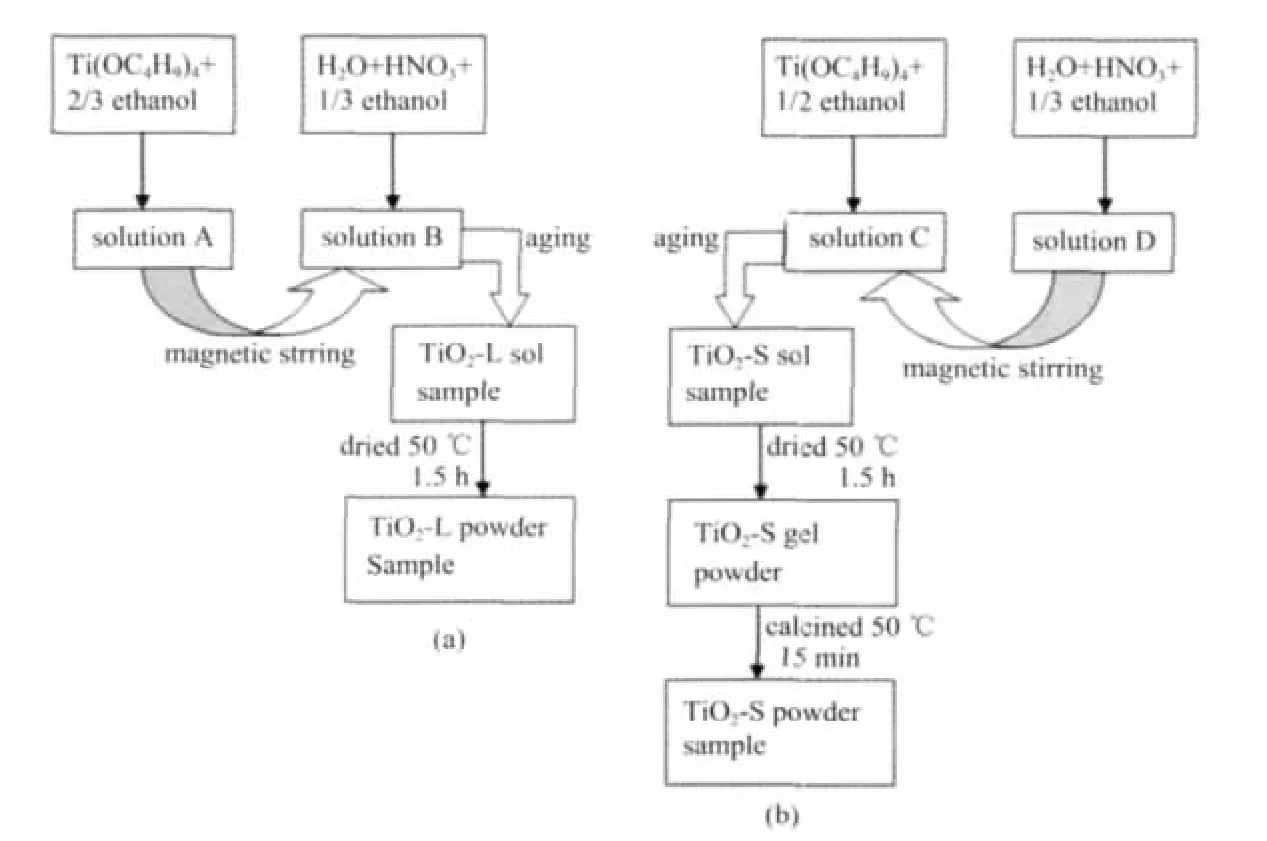
Fig.1 Procedures used to prepare the TiO2-L powder sample(a)and TiO2-S powder sample(b)
1 Experimental
1.1 Preparation of powder TiO2samples
Powder TiO2samples were prepared by the modified sol-gel method and the conventional sol-gel method.The differences between the two synthesis procedures were the molar ratio of the starting materials,the dropping order of the solution preparation,and the heat-treatment of the prepared sol samples.For the modified sol-gel method,the starting solution was with large amount of water,hereafter called as TiO2-L system.The experimental procedure is shown in Fig.1(a).The molar ratio of the staring materials was.Firstly,solution A was prepared by mixing [Ti(OC4H9)4]with two-thirds of amount of ethanol as shown in the above molar ratio setting.Secondly,solution B was prepared by mixing the distilled water with nitric acid,and the rest onethird of the ethanol.Then solution A was added dropwise to solution B under vigorous stirring.After aging for a certain period of time,the transparent sol was obtained,hereafter called as TiO2-L sol sample.TiO2-L sol sample was dried under infrared lamp at about 50℃to obtain TiO2-L powder sample.For the conventional solgel method,the starting solution was with a small amount of water,hereafter called as TiO2-S system.Its experimental procedure is schematically described in Fig.1(b).The molar ratio of the starting materials wasFirstly,solution C was prepared by mixing[Ti(OC4H9)4]with half of the above fixed amount of ethanol.Secondly,solution D was prepared by mixing the distilled water with nitric acid,and the rest half of the ethanol.Then solution D was added dropwise to solution C under vigorous stirring.After aging,the transparent sol sample was obtained.The TiO2-S sol sample was dried under infrared lamp at about 50 ℃ for 1.5 h to obtain the TiO2-S gel powders,which were heated at 500℃for 15 min to obtain the TiO2-S powder sample.
1.2 Characterization
Infrared spectra were recorded by using the Avatar 360 infrared Spectrometric Analyzer.The IR samples were prepared by dropping the same volume of prepared sols on the surface of the KBr tablets,followed by drying under infrared lamp.The crystal behavior and morphologies of the sol samples were observed using a JEM 200CX transmission electron microscope.The crystal behavior of the powder samples was measured by a D/MAX-rA diffractormeter using nickel filtered Cu Kα radiation(λ=0.154 18 nm)with a scanning angle(2θ)of 15°~75°,and a voltage and current of 40 kV and 40 mA.The specific surface area was measured with a MicromeriticsASAP 2020 M+C instrument,using the adsorption of N2at the temperature of liquid nitrogen.
1.3 Photocatalytic activity measurement
The photocatalytic activity of the TiO2-S and TiO2-L powder samples was evaluated by degrading the methyl orange from its aqueous solution under UV light.Three strip tungsten lamps with intensity of 15 W·m-2were used as the light source,whose characteristic emission wavelength is 290 nm.The distance between the light source and the solution level was kept as 12 cm.An amount of 0.1 g of photocatalyst was added into a 10 mL aqueous solution of 10-4mol·L-1methyl orange with a maximum absorption at about 466 nm.Before irradiation,the solution was stirred for 30 min in the dark until adsorption-desorption balance was reached.After illumination,the solution was centrifuged and filtered,and the supernatant was used for the UV-Vis absorption test at the absorption peak(466 nm)before and after photodegradation.A0is the absorbance of the initial methyl orange solution at 466 nm and A is the absorbance of methyl orange solution at 466 nm when t is 3 h,6 h,9 h,12 h,respectively.The photocatalytic activity is characterized by apparent rate constant K,which could be calculated by the equation below[15]

Theabsorptionspectra of the photodegraded methyl orange solution were recorded by a Hitachi U-4100 UVVis spectrophotometer.
2 Results and discussion
2.1 Formation mechanism of nanocrystalline TiO2 in sol with large amount of water
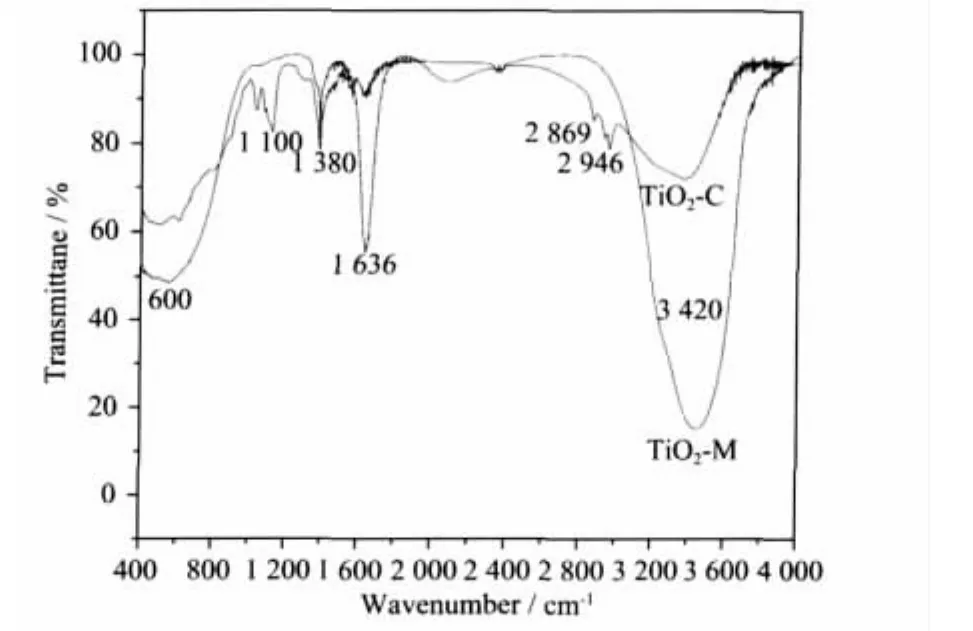
Fig.2 Infrared transmission spectra of the preparedTiO2-S and TiO2-L sol samples
Fig.2 shows the IR transmission spectra of the prepared TiO2-S and TiO2-L sol samples.Both TiO2-S and TiO2-L sol samples show bands around 1 636 and 3 200 to 3 600 cm-1,which correspond to the vibration of hydrogen bonded OH groups[20].The ethanol evaporated IR test samples prepared were dried,therefore it can be concluded that the OH groups are due to the Ti-OH from the hydrolysis of Ti(OC4H9)4.The much stronger bands of Ti-OH groups in TiO2-L means much more Ti-OH groups in the TiO2-L sol sample than that in the TiO2-S sol sample.The band at 600 cm-1in the two sol samples can be assigned to symmetric stretching vibration of the Ti-O-Ti bonds[21].Again,the band at 600 cm-1of the TiO2-L sol sample is stronger than that of the TiO2-S sample,which suggests that the TiO2-L sol sample has more Ti-O-Ti groups than TiO2-S sample.The small bands around 1 380,2 869 and 2 946 cm-1in the TiO2-S sol sample can be ascribed to the vibration of the C-H groups[22].The weaker band around 1 380 cm-1and the absent of bands around 2 869 and 2 946 cm-1in the TiO2-L sol sample suggest less organic residues or organic groups in TiO2-L sol sample than that in TiO2-S sol sample.The band at 1 110 cm-1only seen in TiO2-S sol sample can be assigned to the asymmetric vibration of the Ti-O-C due to unreacted alkoxide groups[23].Accordingly,it can be concluded that in TiO2-L sol sample the starting material Ti(OC4H9)4has already reacted completely,Ti groups exist in the form of inorganic substance containing Ti-O-Ti or Ti-OH groups.On the other hand,in TiO2-S sol sample,Ti groups exist in the form of not only inorganic substance containing Ti-O-Ti or Ti-OH,butalsoorganicsubstancecontainingTi-O-C.
Fig.3 shows the TEM images of TiO2-L and TiO2-S sol samples.It can be seen that spherical particles with diameters of 3~7 nm are synthesized in TiO2-L sol sample.Fig.3(b)shows the electron diffraction patterns.The diffraction rings are indexed,and shown in Table 1,which are in good agreement with the crystal plane indexes of the anatase titania.Accordingly,it can be concluded that the anatase TiO2nanocrystalline has already existed in the TiO2-L sol sample before any further heat treatment.From Fig.3(c)and Fig.3(d),no diffraction ring is observed,indicating that the particles in the sol are amorphous.

Fig.3 TEM images:(a)TEM image of TiO2-L sol sample;(b)Electron diffraction(ED)pattern of TiO2-L sol sample;(c)TEM image of TiO2-S sol sample,(d)Electron diffraction(ED)pattern of TiO2-S sol sample

Table 1 Electron diffraction rings of the TiO2-L sol sample
The water amount plays a key role in the formation of TiO2crystal.For the titanium alkoxide,the hydrolysis and condensation both occur by nucleophilic substitution mechanisms,involving nucleophilic addition followed by proton transfer from the attacking molecule to an alkoxide or hydroxo-ligand within the transition state and removal of the protonated species as either alcohol or water.
The possible hydrolysis reactions of Ti(OC4H9)4can be described as follows.

Also,the possible polycondensation reactions can be described as follows.

Usually,the condensation occurs before the completion of hydrolysis.Therefore,the complex processes happen.Reactions among the titanium alkoxide Ti(OC4H9)4,hydroxo-ligands Ti(OC4H9)3OH,Ti(OC4H9)2(OH)2,Ti(OC4H9)(OH)3and intermediate products will take place as follows.
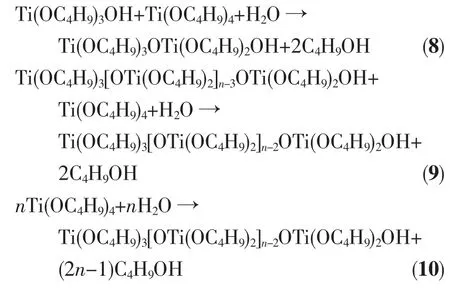
For TiO2-S sol sample,the molar ratio of water to Ti(OC4H9)4is 1.As shown in Fig.1(b),the small amount of water is added dropwise into the ethanol solution of Ti(OC4H9)4,so the hydrolysis of the Ti(OC4H9)4is very slow,the polycondensation proceeds simultaneously with the hydrolysis,as shown in the above equations.Hence the Ti group in TiO2-S sol sample mostly exists as Ti-O-C(see Fig.2),which acts as structural impurities and inhibits the formation of regular structure.So Ti-OTi and Ti-O-H groups in the sol can not connect with each other freely,therefore,no crystalline TiO2is found in TiO2-S sol sample(see Fig.3).
For TiO2-L powder sample,the molar ratio of water to Ti(OC4H9)4is 100.As shown in Fig.1(a),Ti(OC4H9)4is added dropwise into the large amount of water,so the water is always in excess.Hence every Ti(OC4H9)4molecule is surrounded by massive H2O molecules,which makes the titanium precursor hydrolyze quickly and completely as follows.

Therefore the Ti groups in TiO2-L sol sample exist
in the form of inorganic substance containing Ti-O-Ti or Ti-OH groups,and there is no Ti-O-C groups in the sol(see Fig.2),which is beneficial for the connection of the Ti-OH or Ti-O-Ti and formation of the unit-[TiO6]octahedron.With the rearrangement of the [TiO6]octahedron units after aging for a certain time,the TiO2nucleates and grows,resulting in the formation of nanocrystalline TiO2in TiO2-L sol sample.
2.2 Properties of nanocrystalline TiO2powders derived from sol with large amount of water
Fig.4 shows XRD patterns of TiO2powder samples.As shown in the figure,no peak is found in pattern a,which is TiO2-S sol derived powder dried under infrared lamp.While typical anatase type TiO2peaks are found in pattern c,i.e.the pattern for TiO2-L sol derived powder dried under infrared lamp.The size of the formed anatase TiO2crystals is calculated using the Scherrer equation from the half-width of the(101)anatase reflection.
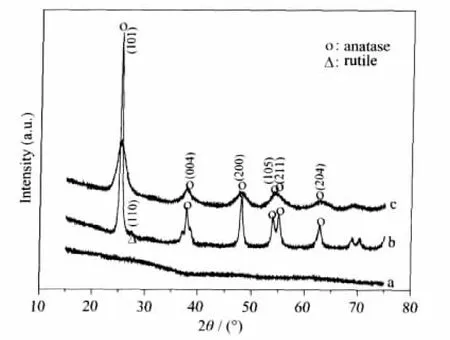
Fig.4 XRD patterns for TiO2powder samples:(a)TiO2-S gel powders prepared by drying the TiO2-S sol sample under infrared lamp at about 50℃;(b)TiO2-S powder sample prepared by calcining the TiO2-S gel powders at 500℃,(c)TiO2-L powder sample prepared by drying the TiO2-L sol sample under infrared lamp at about 50℃
The grain size of TiO2-L powder is 3.5 nm,fairly in agreement with the TEM result(see Fig.3(a)).This indicates that crystal growth does not occur during infrared lamp drying,confirming that nanocrystalline TiO2particles are formed in TiO2-L sol before any heat-treatment.
b in Fig.4 is the XRD pattern for TiO2-S sol derived powder heated at 500℃.It can be found that not only strong and sharp peaks of anatase TiO2appear,but also small peak at 2θ=27.5°corresponding to rutile type TiO2(110)appears.The grain size of anatase and rutile in TiO2-S powder heated at 500℃is 16.8 and 12.3 nm,respectively,both are much larger than that in TiO2-L powder.
Fig.5 shows ln(A0/A)-t plots of TiO2-L powder,TiO2-S powder heated at 500℃and the commercial Degussa P25 crystallineTiO2.The degradation of methyl orange aqueous system containing TiO2powders follows the pseudo-first order kinetics.The result shows that the photocatalytic activities are in the order:P25<TiO2-S powder<TiO2-L powder.In addition,the SBETvalues of the P25,TiO2-S and TiO2-L sample are 55,74,120 m2·g-1,resepectively.Comparing with that of P25,the higher photocatalytic activity of TiO2-S powder can be ascribed to its higher specific surface area.So the TiO2-S powder shows better photocatalytic activity than P25.On the other hand,the particle size of TiO2-L powder is about 3.5 nm,which is smaller than that of TiO2-S powder.So TiO2-L powder owns higher specific surface area than TiO2-S powder.Moreover,the size of TiO2-L nanocrystalline(3.5 nm)approaches the Bohr radius of anatase type TiO2[24-25],which causes quantum-size effect.The quantum-size effect results in split of the energy level of TiO2,which causes an increase in its photocatalytic oxidation-reduction potential and thus enhances the photocatalytic activity.Accordingly,the TiO2-L powders show better photocatalytic activity than TiO2-S powders although the crystal intensity of the TiO2-L powder is much weaker than that of TiO2-S powd er.
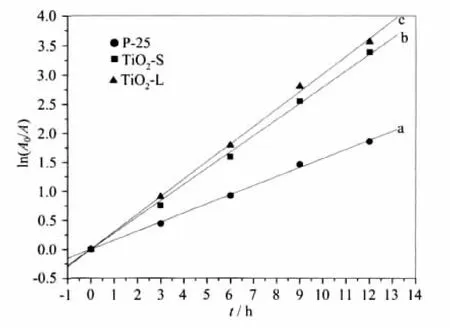
Fig.5 Photocatalytic degradation of methyl orange on P-25(Fig.5a)and prepared TiO2-S powder sample(Fig.5b)and prepared TiO2-L powder sample(Fig.5c)
3 Conclusions
The formation mechanism of nanocrystalline TiO2derived from sol with large amount of water was studied.It is found that the nanocrystalline TiO2has already existed in the sol.The large amount of water makes the titanium precursor hydrolyze quickly and completely before polycondensation.[TiO6]units are formed during polycondensation,thus favoring the formation of nanocrystalline TiO2.The grain size derived from the sol with large amount of water is 3.5 nm.The fine nanocrystalline sample shows better photocatalytic activity than powders derived from the conventional solgel method and commercial photocatalyst Degussa P25.
Acknowledgment:This work is supported by National Natual Science Foundation of China,under grant No.50672086,and Zhejiang Province Fund of Science and Technology,under grant No.Y200909120.
[1]Castro A,Nunes M,Carvalho A,et al.Solid State Sci.,2008,10:60-606
[2]Kim E,Hahn S.Mater.Lett.,2001,49:244-249
[3]Tang Z,Zhang J,Cheng Z,et al.Mater.Chem.Phys.,2002,77:314-317
[4]WANG Zhen-Xing(王振兴),DING Shi-Wen(丁士文),ZHANG Mei-Hong(张美红).Chinese J.Inorg.Chem.(Wuji Huaxue Xuebao),2005,21(3):437-440
[5]Zhao Y,Li C,Liu X,et al.Mater.Lett.,2007,61:79-83
[6]Ren W,Ai Z,Jia F,et al.Appl.Catal.B,2007,69:138-144
[7]Reddy K,Reddy C,Manorama S.J.Solid State Chem.,2001,158:180-186
[8]HUANG Dong-Sheng(黄东升),CHEN Chao-Feng(陈朝凤),LI Yu-Hua(李玉花),et al.Chinese J.Inorg.Chem.(Wuji Huaxue Xuebao),2007,23(4):738-742
[9]Zhu J,Yang J,Bian Z,et al.Appl.Catal.B,2007,76:82-91
[10]YAO Chao(姚 超),YANG Guang(杨 光),LIN Xi-Ping(林西平),etal.ChineseJ.Inorg.Chem.(WujiHuaxueXuebao),2004,12(12):1821-1826
[11]Satoshi T,Susumu S,Hidefumi O,et al.Thin Solid Films,2001,392:338-344
[12]Ding Z,Hu X,Lu G,et al.Langmuir,2000,16:6216-6222
[13]Zhao G,Utsumi S,Kozuka H,et al.J.Mater.Sci.,1998,33:3655-3659
[14]ChengB,YuJ,ZhangX.J.Mater.Sci.Lett.,2003,22:967-970
[15]Bavykin D,Friedrich J,Walsh F.Adv.Mater.,2006,18:2807-2824
[16]Li H,Zhao G,Song B.J.Mater.Lett.,2008,62:3395-3397
[17]Hu Y,Yuan C.J.Cryst.Growth,2005,274:563-568
[18]Kanna M,Wongnawa S.Mater.Chem.Phys.,2008,110:166-175
[19]Chen Z,Zhao G,Li H,et al.J.Am.Ceram.Soc.,2009,92:1024-1029
[20]Huang M,Kuo S,Wu,F,et al.Polymer,2002,43:2479-2487
[21]Thoms H,Epple M,Frfba M,et al.J.Mater.Chem.,1998,8,1447-1451
[22]Bezrodna T,Gavrilko T,Puchkovska G,et al.J.Mol.Struct.,2002,614:315-324
[23]Boccuzzi F,Chiorino,A.J.Phys.Chem.B,2000,104,5414-5416
[24]Joo J,Kwon S,Yu T,et al.J.Phys.Chem.B,2005,109:15297-1530
[25]Toyoda T,Tsuboya I.Rev.Sci.Instrum.,2003,74:782-784
Preparation of Nanocrystalline TiO2by Sol-Gel-Method at Room Temperature
CHEN Zhi-Jun1ZHAO Gao-Ling*,1LI Hong ZHANG Jun-Juan1SONG Bin2HAN Gao-Rong1
(1State Key Laboratory of Silicon Materials,and Department of Materials Science and Engineering,Zhejiang University,Hangzhou 310027)(2Department of Physics,Zhejiang University,Hangzhou 310027)
Nanocrystalline titania(TiO2)particles were obtained at room temperature by a modified sol-gel method starting from a solution with large amount of water.The nanocrystalline TiO2particles prepared with large amount of water at room temperature were characterized by IR,TEM and XRD.Comparing with conventional sol-gel method,the present system offers quick and complete hydrolysis of titanium precursor before polycondensation,thus resulting in[TiO6]units,and the formation of nanocrystalline TiO2particles with an average grain size of 3.5 nm.Moreover,the as-prepared nanocrystalline TiO2powders exhibit a better photocatalytic activity than both of the powders prepared by conventional sol-gel method and the commercial photocatalyst Degussa P25.
nanocrystalline TiO2;modified sol-gel method;mechanism;photocatalytic activity
O614.41+1
A
1001-4861(2010)05-0860-07
2009-10-16。收修改稿日期:2010-03-10。
国家自然科学基金(No.50672086),浙江省科研厅项目(No.Y200909120)资助。*
。 E-mail:glzhao@zju.edu.cn
陈志君,男,25岁,在读硕士;研究方向:光催化剂纳米材料的制备。

